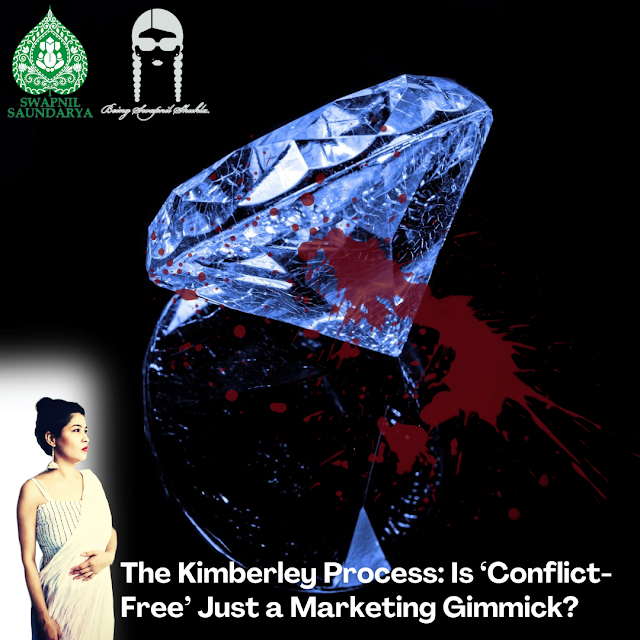The Kimberley Process: Is ‘Conflict-Free’ Just a Marketing Gimmick? By Swapnil Shukla
Do you trust the ‘conflict-free’ label on your diamond? Could it be a convenient excuse to keep us buying without guilt? Today, we’re breaking down the Kimberley Process—a certification system that claims to prevent blood diamonds from entering the market. But is it really effective, or just another smokescreen?
What is the Kimberley Process?
Launched in 2003, the Kimberley Process Certification Scheme (KPCS) was supposed to stop blood diamonds in their tracks. It was marketed as the ultimate safeguard, a way for the industry to assure buyers that they weren’t funding violence. The idea was simple: certify diamonds as "conflict-free" only if they didn’t fund armed conflicts or human rights abuses.
But as the years have gone by, this certification has come under intense scrutiny. Activists, journalists, and even industry insiders have raised doubts about whether the Kimberley Process is a true solution or a broken system that lets blood diamonds slip through the cracks.
The Loopholes and Failures of the Kimberley Process
The Kimberley Process defines "conflict diamonds" narrowly: only diamonds used to fund rebel groups against legitimate governments are banned. This leaves a huge loophole. Diamonds mined by corrupt regimes, who abuse and exploit their people to maintain power, can still be labeled "conflict-free." In short, the Kimberley Process turns a blind eye to the abuse as long as it’s “legal.”
Another shocking fact? Once a diamond leaves a conflict zone and passes through a legitimate country, it’s essentially “laundered” and can be certified as conflict-free. This re-labeling trick means that blood diamonds can still make their way into the market under a veil of legitimacy. The process isn’t just flawed; it’s an open door for shady practices.
The Human Toll: How the Kimberley Process Fails Victims
People continue to suffer under the very system that claims to protect them. Countries like Zimbabwe and Angola, known for forced labor and brutal working conditions, can still export diamonds labeled “conflict-free.” For the miners trapped in these conditions, the Kimberley Process offers no protection, no accountability, and no justice.
Imagine the horror of mining a diamond that funds your own oppression, only to see it sold as a symbol of purity. The Kimberley Process has become a cruel irony for those whose lives are exploited in the diamond trade.
The Marketing Myth of ‘Conflict-Free’ Diamonds
Major jewelers and diamond retailers proudly flaunt Kimberley-certified diamonds, assuring customers that their purchases are clean. But behind this polished image is a stark truth: many “conflict-free” diamonds aren’t clean—they’re just cleverly rebranded.
This deceptive branding allows the industry to maintain a steady profit while giving consumers a guilt-free buying experience. But make no mistake—labeling a diamond “conflict-free” under the Kimberley Process does not mean it is ethically sourced. It’s a dangerous illusion, one that plays on consumers' desire to feel good about their purchases.
The Reality Check: Are We Being Fooled?
Here’s the truth: the Kimberley Process is less about eliminating blood diamonds and more about preserving the diamond industry’s reputation. It gives the appearance of a solution while ignoring the real issue. By setting the bar so low, the process allows unethical practices to flourish, hiding behind the pretense of regulation.
As consumers, we must question what "conflict-free" really means. Is it enough that our diamonds don’t fund rebels, or should we demand that they don’t fund abuse and exploitation at all?
Alternatives: Seeking Real Change in the Diamond Industry
If the Kimberley Process doesn’t ensure ethically sourced diamonds, what can? The rise of lab-grown diamonds and fully traceable diamonds from ethical mines offers consumers a way to enjoy luxury without the moral compromise. These options allow us to choose beauty that isn’t tainted by exploitation.
Brands that are transparent about their sourcing, using independent certifications and fully traceable supply chains, provide a glimpse of hope. But change starts with us. We have the power to shift demand towards ethical diamonds, forcing the industry to follow suit.
What’s Next?
In our next article, we’ll go beyond the Kimberley Process and explore what true ethical sourcing could look like in the diamond industry. From lab-grown alternatives to blockchain tracking, we’ll uncover the steps needed to ensure our diamonds are truly clean.
Are we ready to confront the glittering lies? It’s time to demand transparency and accountability, to put pressure on the industry to stop hiding behind the Kimberley Process. Let’s make diamonds truly conflict-free—not just in name, but in practice.
Swapnil Shukla, a pioneering jewelry designer and IGI-Certified Polished Diamond Grader, has redefined the jewelry and fashion industry by inventing the genre of Jewelry Journalism in Hindi. As India's first Jewelry Journalist, her innovative work bridges the gap between high-end jewelry trends and sustainability, making them accessible to Hindi-speaking audiences. A passionate advocate for eco-friendly practices, Swapnil has brought cultural heritage, history, and symbolism into her narratives, contributing to the preservation of indigenous jewelry traditions. Her trailblazing efforts are transforming jewelry journalism into a literary art, setting new benchmarks for responsible design and storytelling.
No part of this publication may be reproduced , stored in a retrieval system or transmitted , in any form or by any means, electronic, mechanical, photocopying, recording or otherwise, without the prior permission of the copyright owner.
Copyright infringement is never intended, if we published some of your work, and you feel we didn't credited properly, or you want us to remove it, please let us know and we'll do it immediately.





Comments
Post a Comment